
The Royal Observatory, Greenwich is an observatory situated on a hill in Greenwich Park in south east London, overlooking the River Thames to the north. It played a major role in the history of astronomy and navigation, and because the Prime Meridian passed through it, it gave its name to Greenwich Mean Time, the precursor to today's Coordinated Universal Time (UTC). The ROG has the IAU observatory code of 000, the first in the list. ROG, the National Maritime Museum, the Queen's House and the clipper ship Cutty Sark are collectively designated Royal Museums Greenwich.
Timeline of telescopes, observatories, and observing technology.
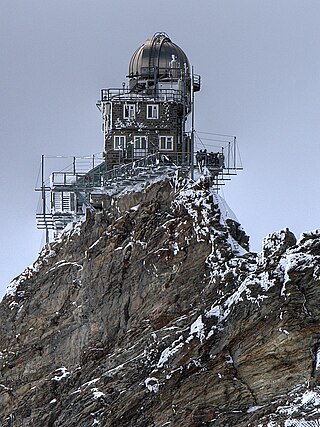
An observatory is a location used for observing terrestrial, marine, or celestial events. Astronomy, climatology/meteorology, geophysics, oceanography and volcanology are examples of disciplines for which observatories have been constructed. Historically, observatories were as simple as containing an astronomical sextant or Stonehenge.
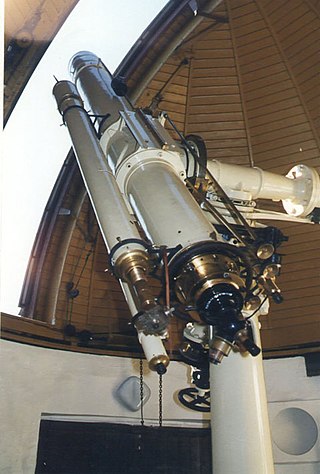
A refracting telescope is a type of optical telescope that uses a lens as its objective to form an image. The refracting telescope design was originally used in spyglasses and astronomical telescopes but is also used for long-focus camera lenses. Although large refracting telescopes were very popular in the second half of the 19th century, for most research purposes, the refracting telescope has been superseded by the reflecting telescope, which allows larger apertures. A refractor's magnification is calculated by dividing the focal length of the objective lens by that of the eyepiece.
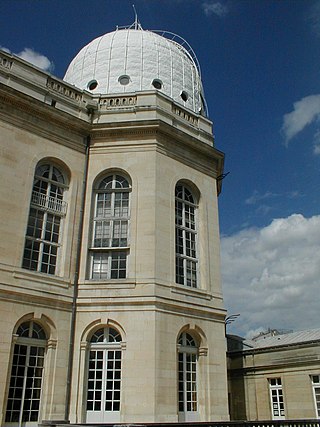
The Paris Observatory, a research institution of the Paris Sciences et Lettres University, is the foremost astronomical observatory of France, and one of the largest astronomical centers in the world. Its historic building is on the Left Bank of the Seine in central Paris, but most of the staff work on a satellite campus in Meudon, a suburb southwest of Paris.
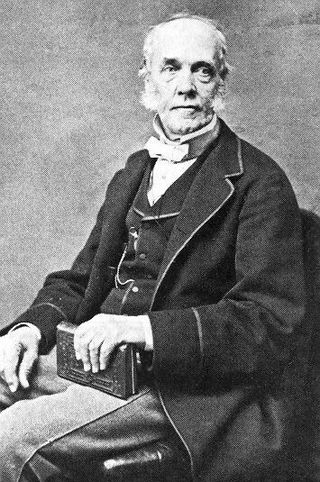
William Lassell was an English merchant and astronomer. He is remembered for his improvements to the reflecting telescope and his ensuing discoveries of four planetary satellites.

The Anglo-Australian Telescope (AAT) is a 3.9-metre equatorially mounted telescope operated by the Australian Astronomical Observatory and situated at the Siding Spring Observatory, Australia, at an altitude of a little over 1,100 m. In 2009, the telescope was ranked as having the fifth-highest-impact of the world's optical telescopes. In 2001–2003, it was considered the most scientifically productive 4-metre-class optical telescope in the world based on scientific publications using data from the telescope.

The Isaac Newton Telescope or INT is a 2.54 m (100 in) optical telescope run by the Isaac Newton Group of Telescopes at Roque de los Muchachos Observatory on La Palma in the Canary Islands since 1984.
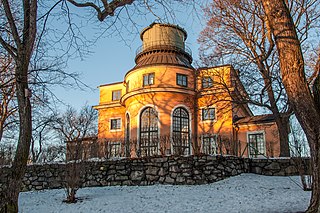
The Stockholm Observatory is an astronomical observatory and institution in Stockholm, Sweden, founded in the 18th century and today part of Stockholm University. In 1931, the new Stockholm Observatory, nicknamed "Saltis", was inaugurated on the Karlsbaderberget at Saltsjöbaden, near Stockholm, and operated until 2001.

The Institute of Astronomy (IoA) is the largest of the three astronomy departments in the University of Cambridge, and one of the largest astronomy sites in the United Kingdom. Around 180 academics, postdocs, visitors and assistant staff work at the department.

Roque de los Muchachos Observatory is an astronomical observatory located in the municipality of Garafía on the island of La Palma in the Canary Islands, Spain. The observatory site is operated by the Instituto de Astrofísica de Canarias, based on nearby Tenerife. ORM is part of the European Northern Observatory.

The Haleakalā Observatory, also known as the Haleakalā High Altitude Observatory Site, is Hawaii's first astronomical research observatory. It is located on the island of Maui and is owned by the Institute for Astronomy of the University of Hawaiʻi, which operates some of the facilities on the site and leases portions to other organizations. Tenants include the Air Force Research Laboratory (AFRL) and the Las Cumbres Observatory Global Telescope Network (LCOGTN). At over 3,050 meters (10,010 ft) in altitude, the summit of Haleakalā is above one third of the Earths's troposphere and has excellent astronomical seeing conditions.

South African Astronomical Observatory (SAAO) is the national centre for optical and infrared astronomy in South Africa. It was established in 1972. The observatory is run by the National Research Foundation of South Africa. The facility's function is to conduct research in astronomy and astrophysics. The primary telescopes are located in Sutherland, which is 370 kilometres (230 mi) from Observatory, Cape Town, where the headquarters is located.

The Royal Observatory, Edinburgh (ROE) is an astronomical institution located on Blackford Hill in Edinburgh. The site is owned by the Science and Technology Facilities Council (STFC). The ROE comprises the UK Astronomy Technology Centre (UK ATC) of STFC, the Institute for Astronomy of the School of Physics and Astronomy of the University of Edinburgh, and the ROE Visitor Centre.

Grubb Parsons was a historic manufacturer of telescopes, active in the 19th and 20th centuries. They built numerous large research telescopes, including several that were the largest in the world of their type.

The Norman Lockyer Observatory, the Lockyer Technology Centre, and the Planetarium, is a public access optical observatory 1 mile (1.6 km) east of Sidmouth, East Devon in South West England. It houses a number of historical optical telescopes, including the Lockyer Telescope, and is operated by Norman Lockyer Observatory Society (NLOS).
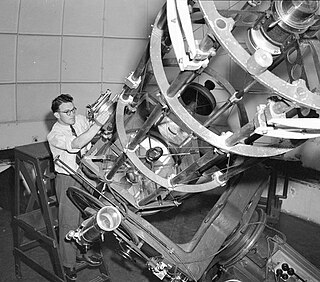
Sidney Charles Bartholemew "Ben" Gascoigne was a New Zealand-born optical astronomer and expert in photometry who played a leading role in the design and commissioning of Australia's largest optical telescope, the Anglo-Australian Telescope, which for a time was one of the world's most important astronomical facilities. Born in Napier, New Zealand, Gascoigne trained in Auckland and at the University of Bristol, before moving to Australia during World War II to work at the Commonwealth Solar Observatory at Mount Stromlo in Canberra. He became skillful in the design and manufacture of optical devices such as telescope elements.

Hugh Ernest Butler FRSE MRIA FRAS was a pioneering Welsh-born astronomer. Wartime work included important contributions to anti-aircraft gunnery followed in peacetime by major contributions to galactic and extragalactic research particularly via ballistic rockets. He promoted the idea of an orbiting space telescope as early as 1958.



















